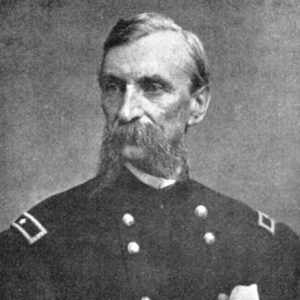calsfoundation@cals.org
Alexander Asboth (1811–1868)
Born in Hungary, Alexander Sandor Asboth served in the Hungarian army and then in the Union army during the Civil War, commanding troops at the Battle of Pea Ridge. After the war, he served as the U.S. ambassador to Argentina.
Asboth was born on December 18, 1811, in Keszthely, Hungary. He trained at the Academy of Selmecbánya to become an engineer. Asboth participated in the Hungarian Revolution of 1848, serving as an officer in the effort to break away from the Austrian Empire and create an independent country. The revolution was ultimately unsuccessful, and Asboth first fled to Turkey and then immigrated to the United States in 1851.
Asboth worked as an engineer and became a U.S. citizen in 1852. He worked for landscape architect Frederick Olmstead and helped survey Central Park in New York City. At the outbreak of the Civil War, Asboth served as the chief engineer on the staff of Major General John C. Fremont in St. Louis, Missouri. Fremont appointed Asboth a brigadier general, but the nomination was not acted upon by the U.S. Senate. Nevertheless, Asboth commanded troops in battle using that rank.
Asboth commanded the Second Division of the Army of the Southwest during the Pea Ridge Campaign in early 1862. In this role, he led an organized brigade and several unorganized units and served under the direct command of German native Brigadier General Franz Sigel. The division consisted of the Second, Third, and Fifteenth Missouri Infantry Regiments, the Fourth and Fifth Missouri Cavalry, and two batteries of light artillery. Units under Asboth’s command crossed into Arkansas on February 18, capturing about thirty-two Confederates belonging to the Seventeenth Arkansas Infantry Regiment at Bentonville (Benton County). The Federals gave the oath of allegiance to local civilians and took large quantities of supplies from the area. One member of the Fifth Missouri Cavalry was killed while looking for whiskey in the town, and his body was discovered in an outhouse. The Federal troops responded by burning most of Bentonville.
The Federal army continued to maneuver in northwestern Arkansas, and Asboth led another expedition a few days later, taking Fayetteville (Washington County) on February 23. Confederate troops burned much of the town as they retreated. Issuing the oath of allegiance to more civilians, Asboth asked his commander, Brigadier General Samuel Ryan Curtis, permission to hold the town. Curtis denied permission, citing the long supply lines supporting the army and the threat of attack.
At the Battle of Pea Ridge on March 6 and 7, Asboth ably led his troops in battle along Telegraph Road and was wounded in his right arm. Refusing to leave the field, he remained in command of his troops. After the first day of battle, Asboth lobbied Curtis and Sigel to retreat based on the mistaken belief that the Confederate forces substantially outnumbered the Federals. Curtis refused to consider such a move, and the Federal army held on to win the battle the following day.
Asboth received an official promotion to brigadier general on March 21, 1862. After the battle, the Army of the Southwest moved across northern Arkansas and southern Missouri before finally capturing Helena (Phillips County). Asboth and his command were detached from the army near Batesville (Independence County) on May 10 and marched to Cape Girardeau, Missouri, to board steamboats. Serving in the Western Theater, Asboth commanded troops in the Army of the Mississippi and the Army of the Tennessee, and he also spent time as the commander of Columbus, Kentucky. Judged by his superiors to be incompetent, Asboth was moved from command to command, often spending only a short time with each unit. These opinions were based on his time in Columbus, where his disposition of troops led to several defeats. He briefly commanded a division in the 15th Corps before being sent to a post in the 13th Corps on the lower Mississippi River. Rejected by the corps commander, Asboth made his way to New Orleans and reported to Major General Nathaniel Banks.
In November 1863, he assumed command of the Subdistrict of West Florida under orders from Banks and led expeditions against Confederate supply operations. On September 27, 1864, Asboth was wounded when he was shot in the face and left arm during a battle near Marianna, Florida. He did not hold any further field commands but remained active in staff and administrative roles. Asboth received a brevet promotion to major general on March 13, 1865. He mustered out of service on August 24, 1865.
Named as the United States Minister to Argentina and Uruguay in 1866, Asboth served in the role until his death on January 21, 1868, in Buenos Aires, Argentina; he died due to complications from the wound to his face. He was originally buried in the British Cemetery, but his grave was moved in 1923 to another location in the city. In 1990, his remains were returned to the United States and interred in Arlington National Cemetery.
For additional information:
Brueske, Paul T. “Alexander Asboth: Hungarian Separatist and Union Civil War General.” MA thesis, University of South Alabama, 2025.
Eicher, John H., and David J. Eicher. Civil War High Commands. Redwood City, CA: Stanford University Press, 2002.
Griffith, Stephanie. “Patriot Finally Comes Home.” Washington Post, October 24, 1990.
Hess, Earl J. “Alexander Asboth: One of Lincoln’s Hungarian Heroes?” Lincoln Herald 84, no. 3 (1982): 181–191.
Shea, William L., and Earl J. Hess. Pea Ridge: Civil War Campaign in the West. University of North Carolina Press, 1992.
David Sesser
Southeastern Louisiana University


 Alexander Asboth
Alexander Asboth 



Comments
No comments on this entry yet.